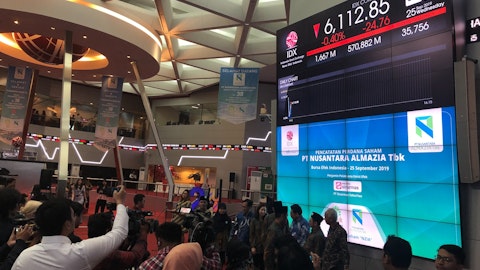Cohen & Steers, Inc. (NYSE:CNS) Q3 2023 Earnings Call Transcript October 19, 2023
Operator: Ladies and gentlemen, thank you for standing by. Welcome to the Cohen & Steers Third Quarter 2023 Earnings Conference Call. During the presentation, all participants will be in a listen-only mode. Afterwards, we will conduct a question-and-answer session. [Operator Instructions] As a reminder, this conference is being recorded Thursday, October 19, 2023. I would now like to turn the conference over to Brian Heller, Senior Vice President and Corporate Counsel of Cohen & Steers. Please go ahead.
Brian Heller: Thank you and welcome to the Cohen & Steers third quarter 2023 earnings conference call. Joining me are our Chief Executive Officer, Joe Harvey, our Chief Financial Officer, Matt Stadler, and our Chief Investment Officer, Jon Cheigh. I want to remind you that some of our comments and answers to your questions may include forward-looking statements. We believe these statements are reasonable based on information currently available to us, but actual outcomes could differ materially due to a number of factors, including those described in our accompanying third quarter earnings release and presentation, our most recent annual report on Form 10-K, and our other SEC filings. We assume no duty to update any forward-looking statement.
Further, none of our statements constitute an offer to sell or the solicitation of an offer to buy the securities of any fund or other investment vehicle. Our presentation also contains non-GAAP financial measures, referred to as adjusted financial measures, that we believe are meaningful in evaluating our performance. These non-GAAP financial measures should be read in conjunction with our GAAP results. A reconciliation of these non-GAAP financial measures is included in the earnings release and presentation to the extent reasonably available. The earnings release and presentation, as well as links to our SEC filings are available in the investor relations section of our website at www.cohenandsteers.com. With that, I’ll turn the call over to Matt.
Matthew Stadler: Thank you, Brian. Good morning, everyone. Thanks for joining us today. As on previous calls, my remarks this morning will focus on our as adjusted results. A reconciliation of GAAP to as adjusted results can be found on pages 18 and 19 of the earnings release and on Slides 16 through 20 of the earnings presentation. Yesterday, we reported earnings of $0.70 per share, compared with $0.92 in the prior year’s quarter, and $0.70 sequentially. The third quarter of 2023 included an adjustment to compensation and benefits that increased the compensation-to-revenue ratio. Revenue was $123.6 million for the quarter, compared with $140.2 million in the prior year’s quarter, and $120.3 million sequentially. The increase from the second quarter was primarily due to the recognition of performance fees from certain institutional accounts, as well as one additional day in the quarter.
Our effective fee rate was 57.6 basis points in the third quarter, compared with 57 basis points in the second quarter. The recognition of performance fees in the third quarter accounted for the majority of the increase in our effective fee rate. Operating income was $43.9 million in the quarter, compared with $60.1 million in the prior year’s quarter, and $43.8 million sequentially. And our operating margin decreased to 35.5% from 36.4% last quarter. Expenses increased 4.2% from the second quarter, primarily due to higher compensation and benefits partially offset by lower G&A. The compensation-to-revenue ratio for the third quarter, which included the adjustment referred to earlier, increased to 42.5% and is now 40.5% for the nine months ended, 100 basis points higher than our previous guidance.
Market depreciation in our asset classes late in the third quarter resulted in quarter-end assets under management being approximately 6% lower than our average assets under management. We expect this to result in lower full-year revenue than we had forecasted when providing our compensation guidance last quarter, which led us to increase the compensation-to-revenue ratio in the third quarter in order to balance employee retention with results to shareholders. The decrease in G&A was primarily due to lower-than-projected costs associated with the now-completed implementation of our new trading and order management system, as well as lower recruitment costs, partially offset by increases in business-related travel and entertainment and hosted conferences.
Our effective tax rate remained at 25.25%, consistent with the guidance provided on our last call. Page 15 of the earnings presentation sets forth our cash and cash equivalents, corporate investments in U.S. Treasury securities, and liquid seed investments for the current and trailing four quarters. Our firm liquidity totaled $279.9 million at quarter end, compared with $257.9 million last quarter, and we have not drawn on our $100 million three-year revolving credit facility. Assets under management were $75.2 billion at September 30th, a decrease of $5.3 billion, or 6.5%, from June 30th. The decrease was due to market depreciation of $4.6 billion, net outflows of $47 million, and distributions of $604 million. Joe Harvey will provide an update on our flows and institutional pipeline of awarded, unfunded mandates.
Let me briefly discuss a few items to consider for the fourth quarter. With respect to compensation and benefits, all things remaining equal, we expect that our compensation-to-revenue ratio will remain at 40.5%, consistent with the year-to-date ratio I just provided earlier. We expect G&A to increase 5% to 7% from the $52.6 million we recorded in 2022, which is lower than the 9% to 11% increase noted on last quarter’s call. Excluding cost projections associated with our new corporate headquarters and the establishment of a new data center, we would expect G&A to be flat when compared with last year. And finally, we expect our effective tax rate will remain at 25.25%. Now I’d like to turn it over to our Chief Investment Officer, Jon Cheigh, who will discuss our investment performance.
Jon Cheigh: Thank you, Matt, and good morning. Today, I’d like to cover our performance scorecard and the market environment during this quarter. And then I’d like to provide our investment viewpoint on what we call the global energy addition as opposed to transition. We believe the consensus on this topic is in the early stages of shifting, and this will help generate strong returns and new investor allocations for our real assets, natural resources, and energy-oriented strategies. Turning to our performance scorecard, for the quarter, 39% of our AUM outperformed, a drop from last quarter’s 98%. While a slight disappointment, we would caution reading too much into the short term. First, philosophically, we believe our three and one-year performances in that order are most important to our clients and prospective investors.
Second, the quarterly alpha pullbacks we experienced occurred in strategies where we are still outperforming over the one and three years. Positively, our performance this quarter was led by preferred securities, most notably low-duration preferreds, which outperformed by 100 basis points and is now up 60 basis points for the year. Following a challenging Q1 for our preferred strategies, we have now seen two quarters in a row of both absolute and relative performance recovery after the banking crisis earlier this year. For the last 12 months, 83% of our AUM outperformed, which is the same as Q2. For the last three, five, and 10 years, our performance track record remains nearly perfect at 95%, 97%, and 100%, respectively. From a competitive perspective, 88% of our open-end fund AUM is rated four or five star by Morningstar, which is consistent with last quarter.
Turning to the market environment, the quarter was challenging for most asset classes with global equities down 3.3% and global bonds declining 3.6%. For the first seven months of the year, cooling inflation and rising prospects for a soft landing drove positive listed market returns. But this quarter, market attention shifted back to concerns about stubborn inflation and high rates, along with new concerns over fiscal deficits and debt sustainability. Our largest asset class, U.S. REITs, declined by 8.6% for the quarter, underperforming U.S. private real estate as measured by NCREIF, which declined 2.2%. Real estate, in our view, had already priced in a 4% treasury yield environment, but clearly struggled with the 10-year pushing closer to 5% by the end of the quarter.
We view the underperformance of listed versus private to be a matter of timing and not a new fundamental trend. This quarterly decline in listed markets implies that we should expect continued write-downs within private markets. Amidst this latest rate-induced pullback in listed REITs, we still see low comparative supply of space, pricing power, and strong balance sheets. Considering valuations in the fundamental picture, we believe investors have an attractive entry point over a multi-year horizon. Indeed, we maintain our conviction that listed markets today are priced for strong forward returns, and particularly so versus private markets. Real assets modestly declined during the quarter, but outperformed a 60-40 portfolio. Commodities were the big story, up 4.7%, as energy and the petroleum complex surged on deeper OPEC+ production cuts, as well as falling Russian crude oil exports and stronger global demand, which pushed Brent crude oil prices to 10-month highs in the mid-90s.
In addition, after five straight quarters of surpluses, the quarter’s expected deficit of 1.5 million barrels per day was the largest since the fourth quarter of 2021, and drove OECD supply inventories further below their five-year average. As expected, these same developments drove a 4.4% quarterly return for natural resource equities. We are closely monitoring developments in the Middle East following the terrorist attacks on Israel and the war which has ensued. While oil fundamentals have remained unaffected, at least for the moment, tail risks for the global economy and certainly commodity prices have all increased. Moving to listed infrastructure, the asset class fell nearly 8% during the quarters. Utilities, particularly in North America, tend to be the most rate-sensitive part of our universe and led the decline.
All major utility subsectors, electric, gas, and water were down between 7% and 11% during the quarter. Also impacting the electric space has been the likely negative impact of both higher cost of capital and lingering supply chain issues impacting returns for new renewable energy projects. Cell tower companies have also been impacted by both higher interest rates as well as lower customer leasing activity. Offsetting these dynamics, midstream energy continues to perform well with the industry up 2.5% on the quarter and now up 7% on the year, as investors appreciate the scarcity value of U.S. energy infrastructure and the attractive free cash flow generation. Lastly, our core preferred security strategy was up 1% for the quarter, beating its benchmark by 90 basis points in outperforming the Bloomberg global aggregate, which was down 3.6%.
Factors that aided our outperformance included our focus on more defensive securities with features such as shorter durations, fixed to reset coupons, and higher yield cushions. From a sector standpoint, security selection in banking, insurance, and utilities contributed to alpha, highlighting our sector diversification. In the near term, we believe preferreds will continue to perform well due to attractive yields, potential for strong total returns as we approach the peak of monetary policy tightening and solid fundamentals as highlighted by healthy bank earnings this quarter. Shifting gears, on our last earnings call, I spent time discussing the strategic case for real assets in both individual and institutional portfolios and how we are in the early stages of a significant and far-reaching macroeconomic regime change defined by higher inflation, lower growth, and greater market volatility.
Today, I want to speak on the so-called energy transition. We believe that the consensus view will shift over time from energy transition to energy addition. Last month, our natural resources and infrastructure portfolio manager Tyler Rosenlicht published an important piece of research entitled, Changing the Imperative from Energy Transition to Energy Addition. You as investors and analysts should expect to see more thought pieces from us that will delve into this theme over time and how it will be a tailwind for real assets, natural resources, and energy. In short, we believe that while the global economy will certainly become much more energy efficient, global energy consumption will still increase in the aggregate to support a growing population, economic growth, and most importantly, rising standards of living in the developing world.
In fact, we forecast a 20% increase in aggregate energy demand by 2040. The world will need both alternative and traditional energy to meet this increased demand. And we believe this feature will create attractive investment opportunities on both sides of the equation. The energy industry is changing dramatically with new efficiencies coming to market, old technologies facing obsolescence and companies reacting to the significant disruption. Some incumbent companies will navigate the change well, while others will not. In either case, the old definition of energy is now obsolete. The expectation that renewables such as wind and solar are ready to fully meet the world’s rising energy demands on their own is at least premature, if not optimistic.

A close-up of a hand holding the deed to a property, symbolizing the real estate investments held. Editorial photo for a financial news article. 8k. –ar 16:9
At the same time, the demise of traditional carbon-intensive energy, such as crude oil and natural gas, has been greatly exaggerated. To be clear, alternative energy is the future. And we expect its production to grow by 155% over the next several decades, which will help satisfy growing energy demand. However, we estimate this still will only cover roughly 35% of future energy needs, which showcases why the world will continue to rely on and invest in traditional energy. The marketplace cannot and will not be dependent on one energy source to the exclusion of others. With the exception of coal, we are likely in a quote unquote “more of everything world” for the next few decades. Indeed, we believe investing in both traditional and alternative energy is the way forward, as it replicates what the world will need to lift an ever-growing population to a higher standard of living and economic equality.
When looking at the prolonged energy transition picture, we believe that blending traditional energy with alternative investments can also create a compelling risk-return profile for investors. This emerging energy addition consensus will be a key driver of returns and increased allocations into our energy, natural resource equities, and broader real asset strategies. With that, let me turn the call over to Joe.
Joe Harvey: Thank you, Jon. Good morning, everyone. I’d like to first briefly touch on the macro environment, then discuss our third quarter business fundamentals and outlook. During the third quarter, the emergence of bond vigilantes focusing on the US federal deficit and potential for sticky inflation caused bond yields to rise, furthering the higher for longer view and pressuring valuations on risk assets. While our average AUM for the quarter was $80 billion, we ended the quarter at $75 billion. Our largest asset classes had greater depreciation than the S&P 500’s decline of 3.3%. For example, US REITs declined 8.6%. Energy was the winner in the quarter, with oil prices up 29% and energy equities up 12%. Our interest rate sensitive assets represent a much larger percentage of our total AUM than does the energy-sensitive components.
Our flow results were better than what may have been expected considering the market environment. Firm-wide net outflows were $47 million in the third quarter, an improvement from the second quarter when we had $512 million of outflows. Year-to-date net outflows have totaled $1.06 billion, an annualized decay rate of 2%. In the quarter, open-end funds had outflows of $360 million, led by U.S. open-end funds, including our two preferred stock funds, which accounted for $222 million of outflows. The institutional channel was positive in the quarter with $190 million of net inflows in advisory and $123 million of net inflows through sub advisory. The wealth channel had net outflows across all vehicle types including open-end funds, SMA, UMA accounts, and offshore [USITS] (ph) vehicles.
In the US open-end funds, seven of 11 funds had outflows reflecting the current risk off market sentiment. We did see inflows into three of our REIT funds, totaling $67 million. The greatest outflows came from our low-duration preferred stock fund, symbol LPX, which had $138 million out, as short-term treasury yields of 5.5% now exceed the 5.2% yield on LPX. Net outflows from our core preferred fund CPX were $84 million, which reflects steady improvement following the turmoil in the U.S. regional banking sector earlier in the year. We also saw outflows from our infrastructure fund, CSU at $65 million and from our multi-strategy real assets fund, RAP, at $70 million, which is the highest they’ve been. Institutional advisory had net inflows of $190 million the first positive quarter since the second quarter of 2021.
We had $274 million of inflows into two existing accounts and outflows of $141 million associated with three account terminations, the lion share being a preferred allocation in our limited partnership vehicle. This redemption should be completed in the fourth quarter with another $184 million out. The Sub Advisory ex-Japan net inflows were driven by three new mandates totaling $234 million, partially offset by trims in three existing strategies totaling $107 million. The three new mandates included a REIT completion strategy and two multi-strategy real assets portfolios. Japan’s sub-advisory was virtually flat, with outflows equal to $2 million. Japan has been a source of relative strength, led by one of Daiwa Asset Management’s US REIT mutual funds.
Japanese interest rate increases have not kept pace with the rise in global rates and the US dollar has been strong versus the end, both dynamics helping REIT flows in Japan. In addition, our partner, Daiwa, has stepped up marketing efforts for those funds. Our one unfunded pipeline was $784 million compared with $1.1 billion last quarter and the three-year average of $1.3 billion. Tracking the change from last quarter, $532 million funded into six accounts, $415 million was added to the pipeline from five new mandates, including $161 million for our private real estate vehicles, and $233 million was terminated, mostly from one OCIO client where the underlying client’s strategic allocation was de-risked. While client decision-making has been slow, activity picked up in the third quarter and continues.
Turning to our outlook, we believe we are well positioned by way of our corporate strategy, how we’re organized, and the clarity of our priorities. In terms of the things within our control, our relative performance continues to be strong, and we have invested prudently in new strategies such as private real estate, and have seeded new strategies such as infrastructure opportunities and the future of energy. We have also expanded our distribution capabilities to include private real estate and have allocated more resources in Asia and have invested in our corporate infrastructure to accommodate more and increasingly sophisticated clients. We are better organized to strategically partner with investors and help them build better performing and diversified portfolios.
What’s challenging is the regime change in the macro economy. This shift is taking a very long time, which, with reflection is understandable considering that the cumulative effects of 12 years of monetary stimulus cannot be unwound in a quarter or two. Factor in geopolitical tensions and in some cases outright conflict including two wars and the entirety of that macro landscape is less predictable and potentially fragile. Normalization of interest rates at the end of the day is good for the economy and capital allocation, but the increase in the cost of capital and multiple compression presents challenges for businesses and asset owners. To date, that process has mostly manifested in the listed market, but is now developing in the private markets as well.
De-globalization and the shifting geopolitical world order provide added catalysts for our view that inflation will be more prevalent, interest rates will be higher for longer, and central banks will continue to be reactive. As a result, the global economy should experience more volatility. The regime change continues to affect asset allocators’ decision-making. The fact that investors can sideline their capital and earn over 5% in a riskless treasury bill while they wait to see how valuations and the economy evolve makes sense for now. The other question is where private valuation marks will settle out, which is slowing portfolio allocation decisions across the board. We continue to believe that listed real assets are underrepresented in investor portfolios based on their fundamentals, considering return, risk, and diversification.
That said, in the short term, the cyclical dynamics of investors sitting on treasuries and waiting for opportunities to become more visible continues to impact the pace of strategic asset allocation decision-making. Demand for our strategies is well-grounded. We’re seeing takeaway opportunities from underperforming managers, shifts from passive to active, desire for customized completion strategies in real estate, opportunity for optimization of listed and private real estate, and emerging demand for real assets in Asia. We believe that the regime change is creating attractive entry points. We’re advising clients that now is the time to begin averaging into listed REITs with their prices down nearly 30% and with the Fed nearing the end of its tightening cycle and with recession concerns afoot.
Then as private real estate furthers its price correction, we expect buying opportunities to open up in 2024. For preferreds, with a many banking crisis in the rearview mirror and with yields in the 7% to 8% range, we expect prefers to participate in the next fixed income return cycle. As mentioned, with inflation likely to be a greater macroeconomic factor, and the fact that investors are generally short inflation beta, we expect investors will increasingly want allocations to the strategies that constitute our multi-strategy real assets portfolio, including natural resource equities and commodities. Our resource equity strategy is particularly well-suited for the macroeconomic environment we envision. Finally, just as in real estate, investors in infrastructure will look to complement private allocations with listed allocations.
We continue to make progress with our new private real estate vehicles. Our non-traded REIT, Cohen & Steers Income Opportunities REIT has completed its registration and review process with the SEC and all 50 states. The next steps to become operational include drawing from our corporate seed capital commitments and from a multifamily office and commencing our investment strategy. We’re ready to go, but we’ve been patiently waiting for prices to decline further in light of the increase in interest rates and slowing growth. Our expectation has been that prices need to decline 25% to 30% and to generalize, we believe we’re about halfway there. Needless to say, our objective is to start the non-traded REIT with a good track record, while taking advantage of an attractive investment period.
In terms of our closed-end private equity opportunity fund, we continue to raise capital while waiting for private real estate prices to correct. Due to the duration of the regime change and the complexity of these vehicles, it has taken longer to get to market with them. However, this initiative is strategic and we’re seeing the power of having both capabilities from an investing and client perspective. The cost structure supporting the initiative is in place and we believe private real estate is a strategic investment that will provide meaningful operating leverage. We’re optimistic about business opportunities in Asia as investors adopt allocations to listed real assets. As a reminder we opened a Singapore office to complement our Hong Kong office in Asia.
We’ve hired heads of sales in Singapore for both the institutional and wholesale markets. We’ve identified initially $3.5 billion in potential allocations to our asset classes on the institutional side. For the wholesale channel, Singapore has become a destination for private wealth and will complement the distribution for our offshore open-end CCAPs in Europe. Taking all of this into account, we are very busy, focused, and excited about the investment opportunities for active managers amidst regime change. Our priorities for 2024 are centered around delivering great investment performance and working with clients to take advantage of entry points to initiate or add to allocations to our asset classes. I’d like to close by pointing your attention to an 8-K we filed yesterday announcing that Matt Stadler will be retiring next year.
He is a consummate professional and is passionate about our business, about leading our finance department as CFO, and helping to lead the firm on our executive committee. We thank Matt for what will be 20 years of service to Cohen & Steers, and note that his contributions and philosophies will be felt for many years to come. He has talked to you on 75 of these earnings calls, and we will look forward to another three or four based on the timing of finding his successor and executing a smooth transition. Congratulations, Matt. Thank you for listening to our earnings call. Julianne, could you please open the lines for questions?
Operator: Certainly. [Operator Instructions] And our first question comes from John Dunn from Evercore ISI. Please go ahead, your line is open.
John Dunn: Hi, guys. Maybe could you just talk a little more about how you see the flow demand story play out as we potentially get to peak rates for real estate and preferreds. Do people need to get to that peak or do people start looking at before? And maybe afterwards, how you’re thinking about how it plays out.
See also Top 20 Biggest Car Manufacturers by 2023 Revenue and 14 Largest Manganese Mining Companies and Best Manganese Stocks To Buy.
Q&A Session
Follow Cohen & Steers Inc. (NYSE:CNS)
Follow Cohen & Steers Inc. (NYSE:CNS)
Joe Harvey: Let me ask Jon Cheigh to talk a little bit more about how we see the return cycle evolving for real estate and preferreds. Then I’ll follow up with some thoughts on to the extent that you can predict those, which is not — is almost impossible, but we can maybe talk about how we’ve seen things in the past.
Jon Cheigh: Look, in terms of “peak” rates, of course, there’s short rates, and then there’s long end. I think both preferred and REIT returns and their attractiveness of course, have been impacted by more on the long end. And when we are talking to our current investors and prospective investors about preferreds and REITs, and I would say we’re educating them on what has historically happened when we’ve gotten to the end of the so-called rate hiking cycle. So preferreds, for example, some of the research we share is that once the Fed has had its last rate hike over the next 12 months, you tend to see 14% returns for preferreds. This compares to more like 5% for treasury. So I think — and there’s similar kinds of research that we’ve educated our investors on REIT.
So, I think most people fully understand that when we get to peak, whether it’s short or long rates, historically, that’s tended to be amongst the best opportunities within REITs and preferreds. We talk to people with that and we counsel them that, of course, you never really know when you’re there until after the fact. And so that you need to “dollar cost average in”. And so, I think we’ve seen both on the fund side and on the advisory side, some amount of that rebalancing in, but certainly not investor behavior, as we know. They want to see it happen and now has happened. So, we’ve seen some of that net flow demand come in. But certainly, it’s been more muted so far. Maybe I’ll turn it back to Joe to talk about.
Joe Harvey: Sure. Maybe just maybe break it down in terms of wealth versus institutional advisory. So, on the wealth side, historically, advisers investors have typically been more coincident with how the markets move. But you should understand, too, that we have professional allocators and platforms who are using these vehicles, some of whom can be very — move a large amount of money. And there are several that are looking for the Qs and indicators that John mentioned on the REIT side, for example. On the institutional side, we would expect those investors to be more anticipatory and if you kind of follow the past couple of earnings calls, you’ll remember that in the second quarter, we felt like the activity just slowed very significantly just due to the significance of the regime change and investors taking stock of their portfolios.
But we’ve seen activity pick up that was evidenced in our third quarter pipeline numbers where we had a lot of fundings, some of those fundings were just sitting around waiting. We’ve seen some new accounts being won and our activity levels are good. So, the institutional market is getting through the regime change process. And I’d say activity is maybe not normal, but it’s getting closer to normal. Overlying all of this — the comments that I made about the fact that fixed income now presents a real return opportunity. And in particular, with treasury bills of being over 5% in the wealth channel, that’s enabling investors to sit and wait and watch to see how things play out. So, these changes are a process. This regime change, as we’ve talked about, has been one of the longest and dramatic that we’ve seen.
But what I’m excited about, as I said, is the alpha opportunities that are going to come out of it. And that’s why our investment teams are highly focused and motivated to capitalize on these opportunities.




